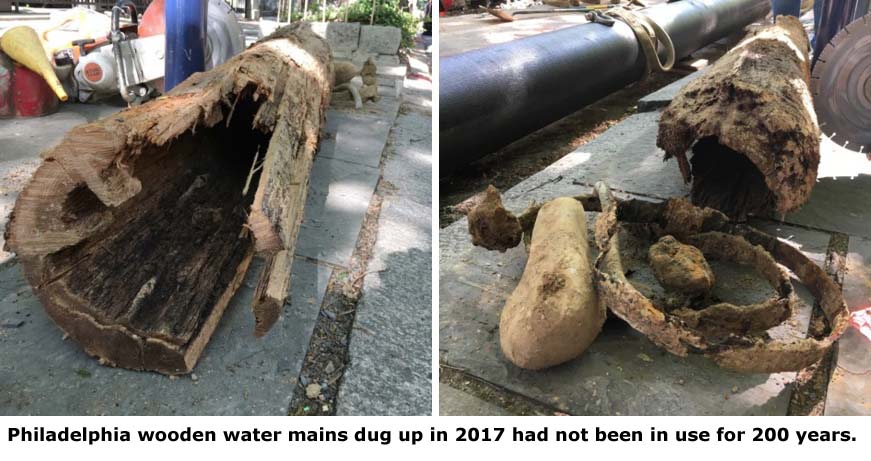
|
|
|
What's IotD? The interesting, amazing, or mind-boggling images of our days. |
|
IotD Stuff |
|
Permalink Latest Image |
|
|
|
Some folks who have noticed IotD
Neatorama |
|
Common image haunts
Astro Pic of the Day |
|
Advertising |
March 25th, 2019: Philly Pipes Up
While Georgie III was trying to win the hearts and minds of his recalcitrant former colonists, by kidnapping sailors, pressing them
into service of the crown, and blocking the trade with everyone else, Philly was piping up. Wooden you?
The wooden pipes used to distribute the water were sections of tree trunks cut to about 12 feet long. Usually White Oak, Spruce,
or Yellow Pine trees were used. Each log was bored through its center with an auger making a 3, 4.5, or 6 inch hole. Keep in mind
the bigger the bore the harder it was to make, but a 4.5” has double, and a 6” quadruple, the volume of the 3” bore.
The ends of the bored logs were hooked together into pipelines with iron couplings and straps.

|
Bounded by two rivers and with water from smaller streams to the north within reach of the city via aqueduct, Philadelphia had numerous choices for the source of its water supply. The Delaware River was deemed unsatisfactory as it was a major port, with all the pollution associated with such activity, as well as the action of the tide and the proximity of marshland. For many years it seemed that the City would accept a proposal from proprietors of the Delaware and Schuylkill Canal to supply water. The canal was never completed, and after much wrangling this proposal also was turned down. The city leaders decided to make providing water a municipal responsibility, with a city-owned water works rather than a system built by a private company which would then lease it back to the city.* The water source finally chosen, the Schuylkill River, was fast-flowing, removed from the City’s population center, and had an extensive upstream watershed that ensured a steady supply. |
I love the name chosen for the group in charge of making it happen, The Philadelphia Watering Committee.


|
The Schuylkill or Lower Engine House located at the foot of Chestnut Street, drew water from the Schuylkill River. This engine pumped water into a brick conduit that ran under Chestnut Street to a second pumping station in Centre Square, at the intersection of Broad and Market streets, where City Hall stands today. There a second engine pumped the water into wooden reservoirs at the top of the building, from which it flowed into a distribution system of wooden pipes into the city. The wooden plumbing supplied timber-tasting water to residents who could either fill their buckets for free at a public standpipe or pay $5 a year to connect directly to faucets in their yards or kitchens. |

|
NOTE ON WOODEN PIPES Wrote the Chief Engineer of the Water Department in his report for 1858: “The last of the old wooden pipes in use for water mains have been taken up and iron pipe substituted... snip The logs taken up were in a remarkable state of preservation, and would have probably answered for many years had it not been for the steam engines which have lately been attached to them for their supply... snip Up to 1832, the city had laid 241,604 feet of wooden pipe, since which time none have been laid, and that which was laid has been gradually substituted by iron pipe. At first, wooden pipe was thought superior to iron, and was used entirely until 1804, when 3,978 feet of the latter were laid; but from that time until 1818 none but wooden pipe was used. In that year 400 feet of iron pipe were laid, and in 1820 the committee on water became satisfied from their experience that they were not only as good as wood, but, in fact, better. Iron pipes were therefore substituted for the wooden ones; they were found not only stronger but more durable, easier laid, and less expensive.” |
| One major defect with Latrobe’s system was that if either engine broke down—the one at the Schuylkill that lifted water into the conduit to Centre Square, or the one at Centre Square, which lifted it into the reservoirs—the whole system went off-line. The reservoir tanks of the system were small, holding just 17,660 gallons. This supply would run out in about twenty-five minutes if no additional water was pumped in, which put the fire-fighting capacity of the city at risk when the system was not working. |
link
SPUCK Friday Mar 29 10:38 PM
Last year our town dug up some ancient redwood water pipes too.
xoxoxoBruce Saturday Mar 30 12:21 AM
I should think that Redwood would last a long time in the ground.
Griff Saturday Mar 30 08:35 AM
and wood be lead free
|
Your reply here?
The Cellar Image of the Day is just a section of a larger web community: a bunch of interesting folks talking about everything. Add your two cents to IotD by joining the Cellar. |